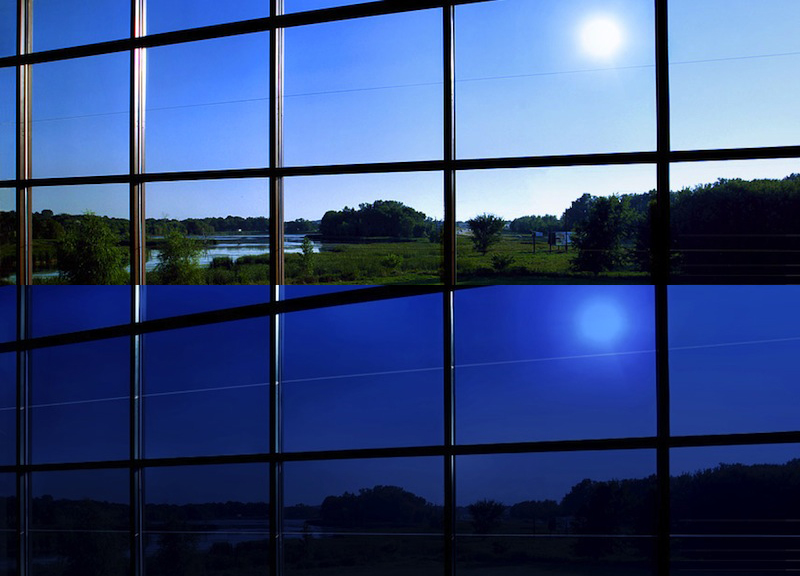New glazing technology is rapidly unfolding. Currently available technologies are seeing performance gains, and cutting-edge products and systems continue to gain a foothold in the mainstream.
Examples of such technologies include:
1. State-of-the-art IGUs. In addition to construction improvements like warm-edge spacers, IGUs are beginning to benefit from alternatives to gas fills. Aerogel insulation, made of synthetic solids that consist almost entirely of air, exhibits extremely low thermal conductivity. Some aerogels can be integrated with polycarbonate sheets to form a translucent cladding material, while others, such as silica aerogels in granular form, can fill the spaces between the glass lites of insulating units, says Ajla Aksamija, PhD, LEED AP BD+C, CDT, Building Technology Researcher with design firm Perkins+Will.
Aksamija also mentions vacuum-insulated glazing (VIG) units. “These units use a vacuum between lites of glass to raise the assembly’s thermal resistance,” she says. With no gas or fill, conduction and convection are virtually eliminated, which also allows the space between the lites (and total glazing thickness) to be greatly reduced, enhancing design flexibility. Patterson notes that vacuum glazing holds the most promise for producing vision glass with a U-factor good enough to justify continuing to build highly glazed facades. He cautions, however, that “a viable solution for widespread application seems to remain beyond the horizon.”
2. Electrochromic glass. Often called smart glass, electrochromic glazing alters its transmittance characteristics when an electrical current is applied, through the use of a specialized lamination that essentially integrates shading into the glazing unit. For instance, one type of smart glass appears frosted until the current is applied, at which point it becomes nearly transparent.
This technology has been in the works for some time, but cost has been a drag on broad market acceptance. There have been problems with the sealants, which are part of the system that carries the electrical current, says Joshua Zinder, AIA, Founding Principal of Joshua Zinder Architecture + Design, who has worked with the products on several occasions.
“A broken seal means a lost electrical connection in the lamination field, which means a loss of the electrochromic functionality in one or more adjacent panels,” he warns, but manufacturers are working to address this problem. “Electrochromic glazing appears to be on the verge of widespread adoption,” says Mic Patterson, Vice President of Strategic Development for Enclos. “The industry has recently invested in the manufacturing infrastructure necessary to produce materials with the right combination of aesthetic and performance attributes at a tolerable price point. These dynamic glazing materials still leave the problem of thermal performance.” Nevertheless, more use of smart glass is likely due to its flexible VLT, which can be integral to daylighting strategies that reduce illumination loads.
3. Building-integrated photovoltaics. In recent years, BIPV systems have shown signs of living up to their promise. With improvements in thin-film PV products to performance levels needed for use in vision glazing, they are getting closer to those of solid solar cells, used in spandrels and shading devices.
Façade orientation and inclination angle are both crucial to the successful integration of PV technology, and the improvement of thin films means that more of a project’s façade area can be integrated for solar harvesting without sacrificing transparency or translucence. Of course, BIPV is an energy-producing technology, not an energy-managing one: Passive solar, which works by managing the temperature of internal thermal mass, according to Cousins, is more closely associated with energy-managing techniques.
One cutting-edge technology is the integrated concentrating solar façade, or ICSF, currently in development by the Center for Architecture Science and Ecology (http://www.case.rpi.edu), a collaboration between Rensselaer Polytechnic Institute and Skidmore, Owings & Merrill. This is a dynamic façade system composed of moving gem-like solar collectors that can harvest daylight and fulfill a number of other energy requirements—heating, cooling, hot water, and electricity production.
4. Phase-change materials. PCMs are solid at room temperature but liquefy at higher temperatures, absorbing and storing heat in the process, says Aksamija. They are currently commercially available integrated into IGUs. Composed of either waxes or salts, PCMs can absorb high exterior temperatures by day and emit the heat to the interior at night.
5. Aluminosilicate glass, which is used to cover the displays of personal digital devices, is extremely thin and highly impact resistant. This glass type is essentially unheard of in building applications, because manufacturing large spans of the glass is prohibitively expensive. However, manufacturers are investing in improving the process because thin, impact-resistant glass could be an enormous boon to architectural glazing.
6. ETFE. Ethylene tetrafluoroethylene is a fluorine-based plastic originally conceived for its anti-corrosive properties, but which also demonstrates benefits for glazing applications, namely low weight, recyclability, and, in double- and triple-ply configurations with a gas fill, excellent thermal properties. But pumps are required to maintain constant air pressure relative to varying wind loads, and (worst-case scenario) when it burns the material releases hydrofluoric acid, which is highly toxic and corrosive.
Editor's note: This article was adapted from our recent AIA CES Discovery course, "Energy-efficiency Glazing Technology." Take the free course.
Related Stories
| Oct 26, 2014
New York initiates design competition for upgrading LaGuardia, Kennedy airports
New York Gov. Andrew Cuomo said that the state would open design competitions to fix and upgrade New York City’s aging airports. But financing construction is still unsettled.
| Oct 16, 2014
Perkins+Will white paper examines alternatives to flame retardant building materials
The white paper includes a list of 193 flame retardants, including 29 discovered in building and household products, 50 found in the indoor environment, and 33 in human blood, milk, and tissues.
| Oct 12, 2014
AIA 2030 commitment: Five years on, are we any closer to net-zero?
This year marks the fifth anniversary of the American Institute of Architects’ effort to have architecture firms voluntarily pledge net-zero energy design for all their buildings by 2030.
| Sep 24, 2014
Architecture billings see continued strength, led by institutional sector
On the heels of recording its strongest pace of growth since 2007, there continues to be an increasing level of demand for design services signaled in the latest Architecture Billings Index.
| Sep 22, 2014
4 keys to effective post-occupancy evaluations
Perkins+Will's Janice Barnes covers the four steps that designers should take to create POEs that provide design direction and measure design effectiveness.
| Sep 22, 2014
Sound selections: 12 great choices for ceilings and acoustical walls
From metal mesh panels to concealed-suspension ceilings, here's our roundup of the latest acoustical ceiling and wall products.
| Sep 15, 2014
Ranked: Top international AEC firms [2014 Giants 300 Report]
Parsons Brinckerhoff, Gensler, and Jacobs top BD+C's rankings of U.S.-based design and construction firms with the most revenue from international projects, as reported in the 2014 Giants 300 Report.
| Sep 9, 2014
Using Facebook to transform workplace design
As part of our ongoing studies of how building design influences human behavior in today’s social media-driven world, HOK’s workplace strategists had an idea: Leverage the power of social media to collect data about how people feel about their workplaces and the type of spaces they need to succeed.
| Sep 8, 2014
First Look: Foster + Partners, Fernando Romero win competition for Mexico City's newest international airport
Designed to be the world’s most sustainable airport, the plan uses a single, compact terminal scheme in lieu of a cluster of buildings, offering shorter walking distances and fewer level changes, and eliminating the need for trains and tunnels.
| Sep 3, 2014
New designation launched to streamline LEED review process
The LEED Proven Provider designation is designed to minimize the need for additional work during the project review process.
















